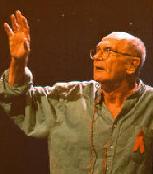SEARCH CurtainUp
REVIEWS
FEATURES
NEWS (Etcetera)
ADDRESS BOOKS
Broadway
Off-Broadway
BOOKS and CDs
OTHER PLACES
Berkshires
London
Los Angeles
Philadelphia
Elsewhere
QUOTES
On TKTS
LETTERS TO EDITOR
FILM
LINKS
MISCELLANEOUS
Free Updates
Masthead
NYC Weather
Save It For the Stage: The Life of Reilly
by Brad Bradley

Charles Nelson Reilly
|
One of the wonders of Reilly's approach is that he changes gears so deftly, pulling us thoroughly away from one wildly funny observation to a heartbreaking one and soon back to another rib-tickler. He embellishes these mood changes with acidly apt asides such as "And you thought this was going to be all about game shows?" or "You see: It's not all autographs and sunglasses".
Reilly has been a fixture on television comedies and game shows for many years, but many in New York came to know him in the early 1960s as a brash comic stage presence, especially in the long-running musicals How to Succeed in Business Without Really Trying and Hello, Dolly! Wider America began to see him on The Ghost and Mrs. Muir and The Tonight Show with Johnny Carson where Reilly left the usually unflappable Carson at a loss for words on numerous occasions. In more recent years he also has been an accomplished director of stage, television and opera.
Act One covers Reilly' s youth, family, and the beginning germ of his performing career. It begins in The Bronx, and he quickly rates his audience on its level of recognition to his geographical origins. A favorable response is rewarded with Reilly's own bolstered enthusiasm.
An effective device that Reilly and collaborator Paul Linke use throughout to bring the people in his life into focus, whether family members, friends or associates, is that each person is treated as a role that needs to be cast. So we are told early that "the part of my mother will be played by Shirley Booth" and"the part of my father will be played by Hume Cronyn." No matter that Booth has been gone for decades, or that Cronyn himself would need to be remembered as he appeared a half-century ago: Such images work brilliantly to keep Reilly at play at his comic best.
Actually, Miss Booth might be too kindly an image for Mrs. Reilly, a formidable woman who today would readily be described as a disaster of a parent and a racist malcontent as well. This occasion also seems a perfect one to dust off the rarely seen word termagant. But hard reality is not the only point here. Otherwise, why would have Reilly so effectively escaped to the fantasies of the stage? Growing up "in an Ingmar Bergman movie", as he describes it, would not seem to be a fun time even in the retelling. But in this presentation, it is glorious fun, even as we totally accept his assessment that the acclaimed gloomy playwright "Eugene O'Neill couldn't get anywhere near this family.""
Reilly recalls vividly such details as his own childhood production of Cinderella on ice skates and gives us fun at his own expense (e.g., getting in the school bus while his extreme nearsightedness made the vehicle unrecognizable at any distance). Recollections of his enchantment being taken by his mother to a real movie palace to see Jeanette MacDonald and Nelson Eddy position him as a real-life Walter Mitty ready to enjoy whatever pleasures life presented. At the Loewe'"s Paradise on the Grand Concourse, he immediately realized "This is a place for me.
Other choice childhood moments include Reilly's getting the role of Columbus in his favorite teacher's grade school play in spite of his censorious mom's objections and his father's desire to move the family to Los Angeles on the encouragement of Walt Disney that his watercolor painting for movie ads was the finest such work. Alas, Mrs. Reilly's unfailing lack of vision killed that dream, among others, and sent the family in a tailspin, Charles and his mother eventually landing in Hartford to squeeze in with assorted relatives including an unforgettable Aunt Lily ("the part played by Claire Trevor"). Poor Dad was left behind in a "state of regret," a phrase Reilly attributes to poet Emily Dickinson.
Act Two has more to do with Reilly as an adult, although that covers a lot of years, considering he was born in 1931. This second half veers dangerously into the self-indulgent, and yet remains captivating. Some trimming of celebrity connections would be in order, although our hero's connection with Uta Hagen and the HB Studio as a nurturing ground for his talent and his unlikely friendship with Mae West both provide essential vignettes. (His mimicry of the latter accepting an honor from the Campfire Girls itself is reward enough for acquiring a ticket.) Equally resonant is notation of his accidental and enduring collaboration with actress Julie Harris. Less successful are gabby recollections of several celebrities including "my friend Burt Reynolds"" and "my friend Ruby Dee."
This show may wear out some audience members with shorter attention spans or perhaps those without any prior awareness of Mr. Reilly. However, Save It For the Stage may just be the perfect tonic for the troubled times, and if a preview is required, the official press agent's biography usefully concludes with the reminder that "Mr. Reilly and his old toupees can be seen eternally and continually on the Game Show Network."
|
SAVE IT FOR THE STAGE: THE LIFE OF REILLY written by Charles Nelson Reilly and Paul Linke performed by Charles Nelson Reilly Set Design: Patrick Hughes Lighting Design: Gregory Cohen Costume Design: Noel Taylor Sound Design: Murmod, Inc. Running time: just under 3 hours including intermission Irish Repertory Theatre, 132 W. 22nd St. (6th/7th)727-2737 9/04/01-10/28/01 (with possible extension); opening 10/03/01 Tuesday - Saturday at 8 p.m., Sunday matinees at 3pm--$35-40. Reviewed by Brad Bradley based on October 7 performance |

6,500 Comparative Phrases including 800 Shakespearean Metaphors by CurtainUp's editor.
Click image to buy.
Go here for details and larger image.




